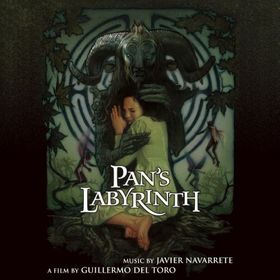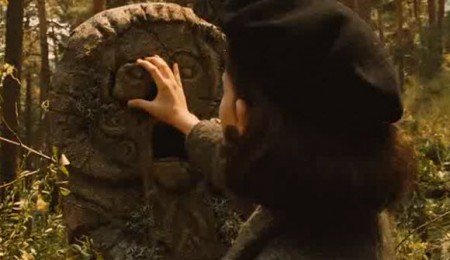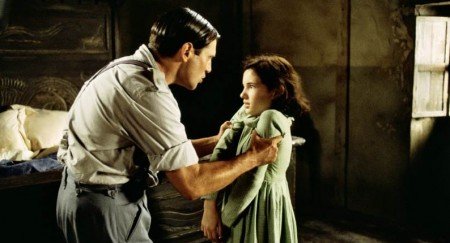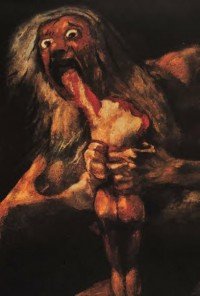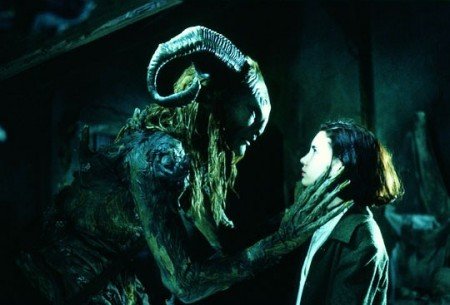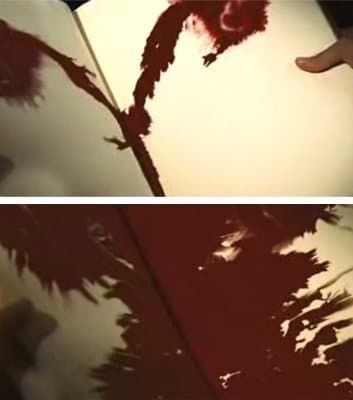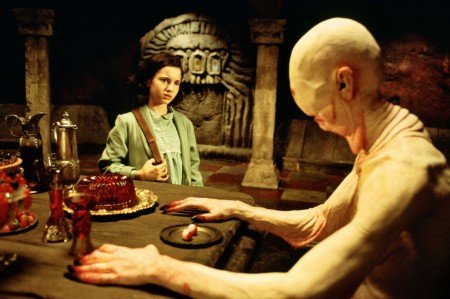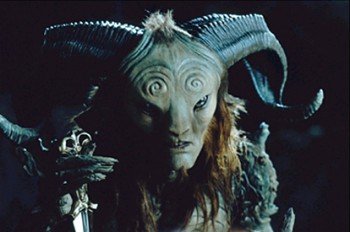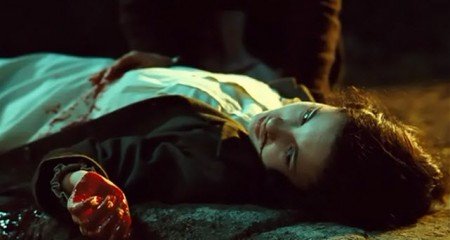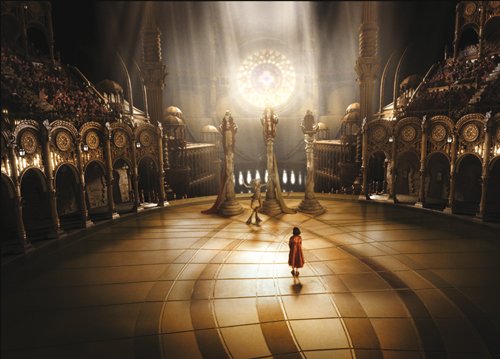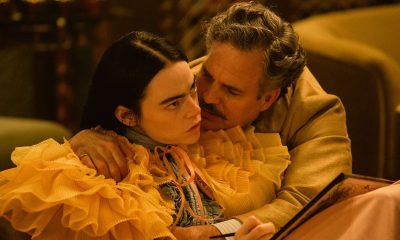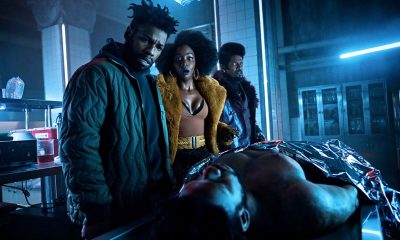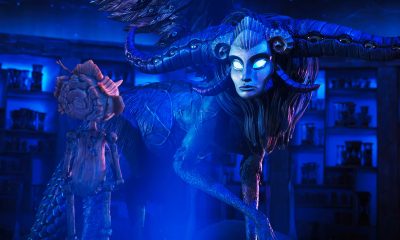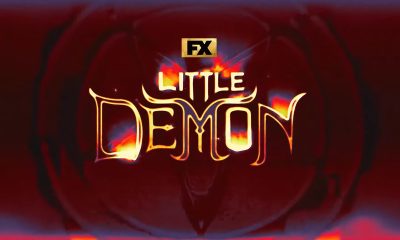Movies and TV
The Esoteric Interpretation of “Pan’s Labyrinth”
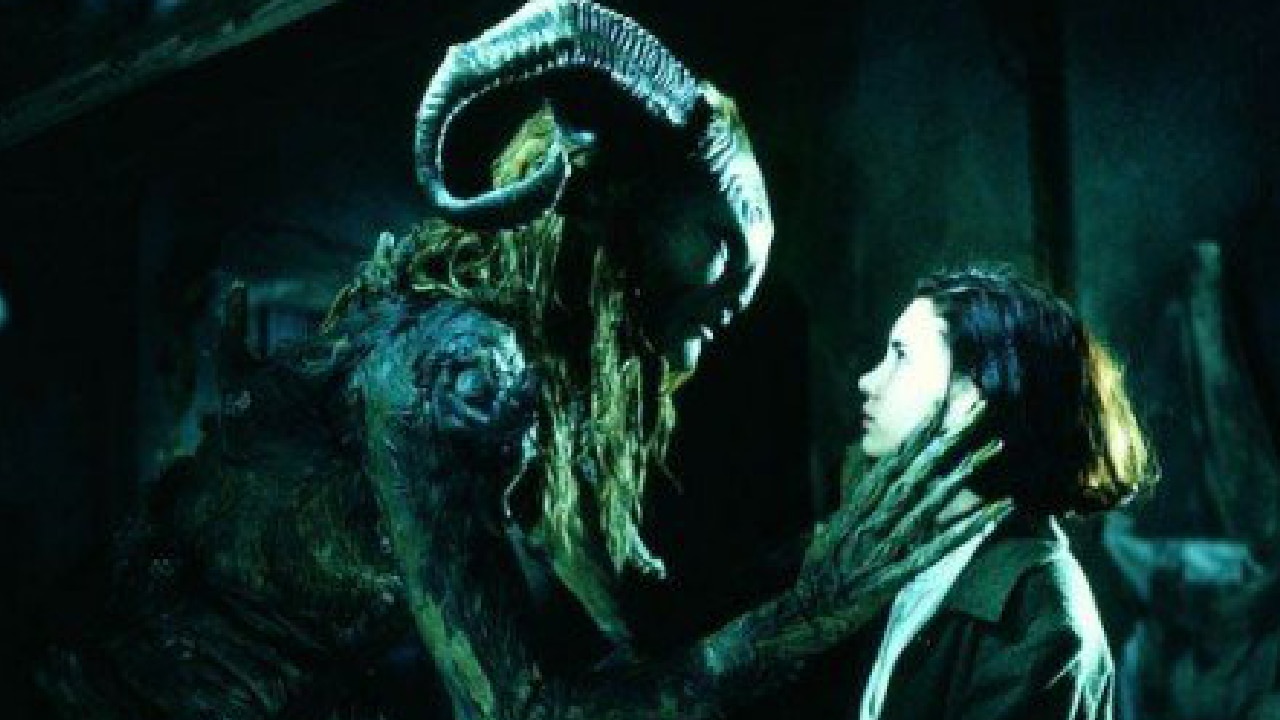
“Pan’s Labyrinth” is a profound movie telling the story of a young girl’s quest to escape the cruelties of Spanish Fascism. The movie also contains a great amount of occult and archetypal symbols telling another story: one of esoteric illumination through a test of character and ritual initiation. We will look at the occult and archetypal symbolism found throughout the movie and their relation to Ofelia’s quest.
Pan’s Labyrinth (Spanish title: El laberinto del fauno) is a Spanish language fantasy film written and directed by Guillermo del Torro, director of The Devil’s Backbone, Hellboy and Blade II. The movie’s compelling storyline, rich mythological background, and strange fantasy world caused many movie critics to consider it as the best movie of 2006.
Like many fairy tales, Pan’s Labyrinth is an allegorical story that can be interpreted in numerous ways and on many simultaneous levels. While researching this movie, I came across psychological, sociological and political interpretations of Pan’s Labyrinth, but almost none relating to the occult symbolism permeating the work and I’ve found almost nothing regarding its underlying esoteric story of initiation. This came as surprise as Del Torro himself described the movie as a “parable” and the numerous references to occult mysteries certainly point this way. We will, therefore, look at the mystical and archetypal symbolism found in the movie and see how they fit into this rich story of esoteric initiation.
One of the reasons why the movie deeply moves its viewers is probably the presence of archetypal myths and symbols that deeply resonate in the collective and personal unconscious:
“Indeed, once upon a time is a good place to start with a film like Pan’s Labyrinth. It is a fairytale above all, an especially dark one too that contains all of those classic mythical archetypes of Jung’s collective unconscious. We think of, for instance, the evil king, the heroine in distress, parallel universes, chimerical creatures, and the marching battle between good and evil as portrayed in the story. These are all universal themes, patterns and character types we see in classical fairytales over and over again; the type that led Jungian analyst Donald Kalsched to assert that “When human resources are unavailable, archetypal resources will present themselves.” The same can be said of our lead princess, Ofelia. A girl stripped of humanity, crushed by grim realities and forced to draw upon the archetypal myths of the collective human imagination.”
– Psycho-Critical Analysis of “Pan’s Labyrinth”: Myth, Psychology, Perceptual Realism, Eyes & Traumatic Despondency
Movie Overview
The movie takes place in the mountains of fascist Spain at a military camp fighting against the rebels. Ofelia, a young girl with a wild imagination, obsessed with books and fairy tales, travels with her weak, pregnant mother to meet her new stepfather, a merciless captain of the Spanish army. Upon her arrival, she discovers a labyrinth and meets a faun that tells her that she is a princess from the “Underworld”. He promises her that she can go there and be reunited with her father as long as she completes three tasks for him. In her attempts to complete these tasks, Ofelia is forced to deal with the reality of mortality, the absurdity of war and the meaning of self-sacrifice.
The tale revolves around the juxtaposition of the harsh and oppressive nature of the real world with the magical and sometimes disturbing fairy tale world of the little girl. The faun (named Pan in the English translation) is a horned beast that guides Ofelia through her initiation process and shows her the way to depart from the absurdity of the material world to re-enter the glory of the spiritual plane, where illuminated beings live: the Underworld.
Having “Eyes to See”
At the beginning of the movie, Ofelia is almost instinctively lead to a mysterious monument depicting the faun with a missing eye. She finds the missing eye and places it back into its socket. A magical insect/fairy suddenly appears: Ofelia’s magical quest can begin. There is a great importance placed on eyes and sight in the movie and this scene tells the viewers, right from the start, that Ofelia’s quest is occult in nature as not many have the “eyes to see” the invisible world she is about to experience.
“Having mentioned sight, the film has much to say about it. Guillermo Del Toro almost seems to presuppose that the viewer needs a third “Zen” eye to capture the quintessential truths buried deep within the film’s archetypal margins. As Derrida posited, the most important meanings are not in the text itself, but “in the margins,” or subtext. In other words, scientists and secularists need to leave the theater. When Ofelia returns the eye of the statue to its rightful place, her fantastical journey immediately begins. Her eyes allow her to see things both visible and invisible, real and unreal, which starkly contrasts with the fascist villain, Captain Vidal, one who punctures the eyes of others and believes not in what cannot be physically seen.”
– Ibid
The importance of the Eye is of the utmost importance in occult symbolism and can be dated back to ancient Egypt with the myth of Horus’ eye being restored by Toth. While the right eye is associated with the perception of concrete and factual information (male side of the brain), the left eye of Horus perceives the mystical, the spiritual and the intuition (the female side of the brain). By placing back the eye in its place, Ofelia restores the all-important balance needed to embark on her alchemical transformation.
Ofelia soon realizes however that the adults surrounding her certainly do not believe in what cannot be physically seen, making her quest quite a lonely one.
The Oppressive Father-Dictator and the Cronus Complex
Once she has arrived at the war camp, Ofelia meets with her new step-father, the cruel and sadistic Captain Vidal. The character is a representation of Spanish Fascism and, on a philosophical level, of the oppressive material world, most people abide in without questioning which prohibits the full emancipation of the being. This phenomenon is known as the “Cronus Complex”, Cronus being the Greek mythological figure representing time, death and harvesting.
“The Cronus Complex is not a murderous tendency per say, since Cronus did not just got rid of his offspring, but a destructive ingestive process which hinders the child’s capacity to exist separately and autonomously from the parent. In consuming his child, Cronus does not only aim to annihilate him but does so by making him part of himself. According to Bolen, since ancient times, the Cronus Complex is a tendency through which male oriented cultures have maintained power. That is evident is systems such as Fascism, one of the most radical mutations of patriarchy.“
– John W. Crandall, The Cronus Complex
Cronus is also known as “father time”. Captain Vidal is often shown looking at and maintaining his watch, time being the most damning limitation of the material world. Ofelia—and everyone around her—is terrified by Captain Vidal but, in order to complete her initiation, Ofelia will need to emancipate herself from this oppressive father figure and, most importantly, get in touch with her oppressed feminine and magical side. Restoring the equilibrium of duality is a necessary step in alchemical transformation.
The Faun and his Labyrinth
Disgusted by her new life, Ofelia is led by a fairy to an overgrown labyrinth where the Faun steps out of the shadows. When she asks him “Who are you?”, he replies “I’ve been called so many names that only the wind and the trees can pronounce. I am the mountain, the forest, the earth. I am … a faun.” He then continues: “It was the moon that bore you. And your real father waits for your return, but first, we must be sure that you have not become mortal”.
In ancient mythology, fauns, satyrs, and the Greek god Pan were somewhat similar as they all bear the hindquarters, legs, and horns of a goat. Pan is a prototype of natural energy and is undoubtedly a phallic deity, representing the impregnating power of the sun. The faun becomes a sort of spiritual guide to Ofelia, helping her through the actual and figurative labyrinth she must go through. Despite the faun’s monstrous appearance—which leads viewers to think at first that he is the “bad guy”—he is actually the only being in Ofelia’s life that understands her desire to “become more” and to reach her full potential. The actual “bad guy” in the movie is not the hideous creature, but the cruel step-father.
The Labyrinth

“Labyrinths and mazes were favoured places of initiation among many ancient cults. Remains of these mystic mazes have been found among the American Indians, Hindus, Persians, Egyptians, and Greeks.” – Manly P. Hall, Secret Teachings of All Ages
Found in the initiation rites of many ancient civilizations, mazes were symbolic of the involvements and illusions of the lower world through which wanders the soul of man in its search for truth. Pan’s Labyrinth is mostly a figurative one as Ofelia must avoid the pitfalls and the dead-ends of the material world in order to be reunited with her true father.
The First Task: Finding the Sacred Feminine
The first task given by the Faun to Ofelia is to retrieve a key from a giant toad who is sucking the life out of an ancient fig tree. There starts the quest for “returning to the womb” and the rekindling the oppressed feminine. The interior of the tree is damp and moist, symbolizing once again the womb-giver of life. The tree itself looks like a uterus.
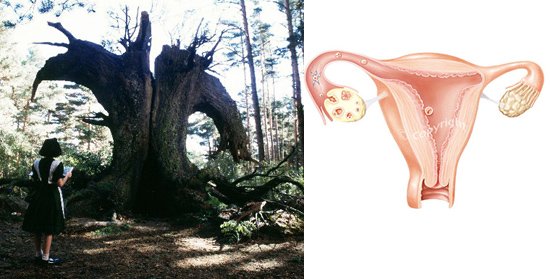
Ofelia wearing a black version of the dress of Alice in Wonderland. Also, a picture of a uterus, in case you forgot what one looks like.
Ofelia’s trauma/fascination with the feminine principle is expressed many times in the movie, mainly through her weak and pregnant mother who ultimately has to give her life to give birth. In one disturbing scene, Ofelia sees in her Book of the Crossroads the outline of a uterus that becomes red, predicting her mother’s complications.
The Second Task: The Pale Man
Having successfully completed the first task, Ofelia receives a second mission from the faun which is the retrieval of a dagger from the Pale Man. There is, however, e important condition: She cannot eat anything there.
The Pale Man is a big flabby creature sitting in front of a great feast. Looking around, Ofelia sees stacks of shoes and depictions of the Pale Man eating children, which is, once again reminiscent of Goya’s depiction of Cronus. The Pale Man is a gruesome representation of the oppressive powers of Ofelia’s world – Captain Vidal, Spanish Fascism and the Catholic Church. To further this comparison, a scene of Vidal having dinner with his guests, including a Catholic priest, is shown in parallel, in which nobody dares to question the Captain’s cruel motives.
Ofelia manages to retrieve the dagger, but on her way out, cannot resist the temptation of eating a big juicy grape, symbolizing the wealth accumulated by the Cronus figures. This awakes the Pale Man, who immediately places his eyeballs in his hands and starts chasing Ofelia.
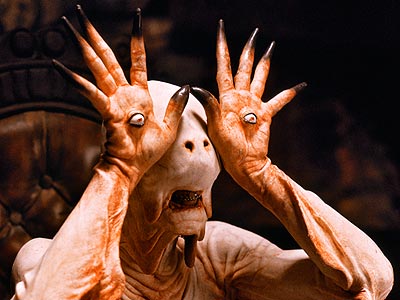
The pale Man has is eyes in his hands, representing the fact that he can only sees what is palpable. It can possible represent the stigmata.
Ofelia manages to escape the Pale Man, but at what cost?
The Third Task: The Ultimate Sacrifice
The Faun was furious at Ofelia for giving in to the temptations of the material world and questioned her worthiness to become a true immortal. He therefore leaves her in coldness of the real world, where Ofelia has to witness war, torment and sadness. Shortly after Ofelia’s mother’s death, however, the faun reappears, to the great joy of the girl. He allows her to complete her initiation, but he demands her complete obedience. For her final task, the Faun asks Ofelia to bring her new born baby brother to the labyrinth at night during the full moon, the prime time to complete a spiritual transformation in occultism.
Ofelia must therefore steal the baby from Captain Vidal by drugging him and runs to the labyrinth, where the faun awaits her.
The faun asks Ofelia to give him the baby so he can prick him with the dagger and obtain a drop of blood from him. Ofelia refuses. The faun loses his patience and reminds her that he requires her full obedience, but she still refuses. At this point, Captain Vidal finds Ofelia, whom, in his point of view, is talking to herself (as he cannot see the faun). He takes the baby from her and shoots her.
Drops of Ofelia’s own blood falls into the labyrinth, thus accomplishing the final task required for her initiation: self sacrifice.
The Initiation
While we see Ofelia laying bloody on the ground, she is also shown in another realm, the Underworld, reuniting with her true parents.
The entire palace bears the shape of a vesica piscis, an ancient occult symbol representing the vulva, the entrance to the womb and the gateway to another world. Standing on three pillars, the father, the mother and the soon to be princess will complete trinity of the Underworld. The faun greats Ofelia, telling her she did well by going against his orders and sacrificing her life to protect her innocent brother. Indeed, a strong will, sacrifice and rebirth are necessary for the completion of an initiation into occult mysteries.
Ofelia is then shown again laying on the floor bloody, making the viewers ask themselves: did this actually happen or is it all in the girl’s imagination?
In Conclusion
Pan’s Labyrinth describes the quest of a young girl unable to cope with the harshness of the physical world, where dehumanization and repression crush her innocent and playful spirit. It has been shown that children often psychologically respond to an unbearable reality by dissociating into a fantasy world, where magic, adventure and wonder are to be found. Ofelia is often reminded by her mother that “magic does not exist her and no one else”. The magical world however seems to exist beyond Ofelia’s imagination. One example is the mystical plant given by the faun, the mandrake, which was healing Ofelia’s mother from her ills, until she found it under her bed and, disgusted by it, burned it.
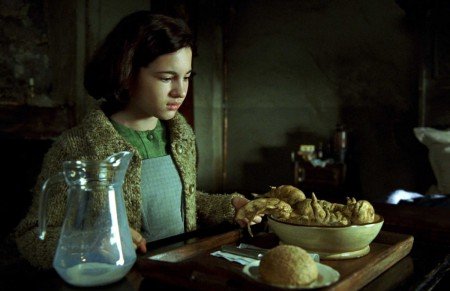
Ofelia with the mandrake, the “plant that wanted to be a man”. Its presence in the movie is a reminder that all magic is not fairy tales and that occult knowledge can have actual applications in real life.
The mandrake is an important plant in occult lore mainly due to the fact that its roots are often shaped like a human body, complete with arms and feet.
“The occult properties of the mandrake, while little understood, have been responsible for the adoption of the plant as a talisman capable of increasing the value or quantity of anything with which it was associated. As a phallic charm, the mandrake was considered to be an infallible cure for sterility. It was one of the Priapic symbols which the Knights Templars were accused of worshipping. The root of the plant closely resembles a human body and often bore the outlines of the human head, arms, or legs. This striking similarity between the body of man and the mandragora is one of the puzzles of natural science and is the real basis for the veneration in which this plant was held. In Isis Unveiled, Madam Blavatsky notes that the mandragora seems to occupy upon earth the point where the vegetable and animal kingdoms meet, as the zoophites and polypi doin die sea. This thought opens a vast field of speculation concerning the nature of this animal-plant.”
– Manly P. Hall, The Secret Teachings of All Ages
This movie is one of opposites and reversals: reality versus fiction, good versus evil, innocence versus adulthood, feminine versus masculine, overworld versus underworld, etc. Even the very ending can be interpreted in two opposite ways: either Ofelia created a fairy-tale world in her head to escape real life and ultimately committed a form of suicide or she’s simply an awakened being who saw what the masses bound to the material world cannot see and ultimately completed her process of illumination to become a true immortal. The story is also an inversion of the usual paradigm for self-actualization: Ofelia’s transformation happens in the shadows and in the dark while enlightenment, as it name says, is associated with light; Ofelia’s illumination happens in the Underworld while spiritual transformation is usually associated with “the heavens”; the initiator himself, Pan, is a deity known for getting drunk in the woods and frolicking nymphs (and the odd goat) while illumination is based on the mastery of one’s lower impulses; the completion of Ofelia’s initiation requires her to crawl in the mud, be chased by a Pale Man and finally spill her blood while the usual path to illumination is based on the master of self and uncorrupted virtue. So what is the true fate of Ofelia? As the last line of the movie states: the clues to the answer can be found by those who have the eyes to see.
- Mockery Ensues
- Official seal of the University of Chile
- New footage shows debauched birthday party Diddy threw for Meek Mill
- The Economist / 2025 / The World Ahead
- Justin Trudeau claims fighting climate change is more important than feeding your kids
- Suspect at center of ISIS inspired Election Day terror plot previously worked for the CIA
- Nina Saemundsson's "Prometheus Bringing Fire" (Los Angeles McArthur Park, circa 1937)
Get an e-mail notification as soon as a new article is published on The Vigilant Citizen.
-

 Latest News2 months ago
Latest News2 months agoThe Controlled Demolition of Diddy
-
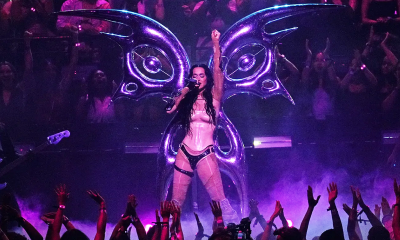
 Music Business2 months ago
Music Business2 months agoThe Hidden Meaning of Katy Perry’s Highly Symbolic Performance at the 2024 VMAs
-
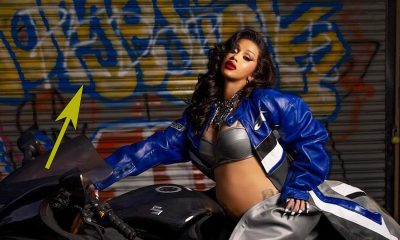
 Pics of the Month2 months ago
Pics of the Month2 months agoSymbolic Pics of the Month 09/24
-
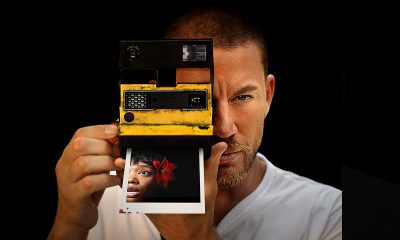
 Movies and TV1 month ago
Movies and TV1 month agoAn In-Depth Look at the Hidden Meaning and Symbolism in “Blink Twice”
-

 Pics of the Month4 weeks ago
Pics of the Month4 weeks agoSymbolic Pics of the Month 10/24
-

 Music Business3 months ago
Music Business3 months agoSomething’s Terribly Wrong With Sabrina Carpenter and her Video “Taste”
-

 Movies and TV2 months ago
Movies and TV2 months agoAn In-Depth Look at the Dark Messages and Symbolism in “Longlegs”
-

 Latest News2 weeks ago
Latest News2 weeks agoKamala’s Campaign Was Objectively the Worst in Recent History
